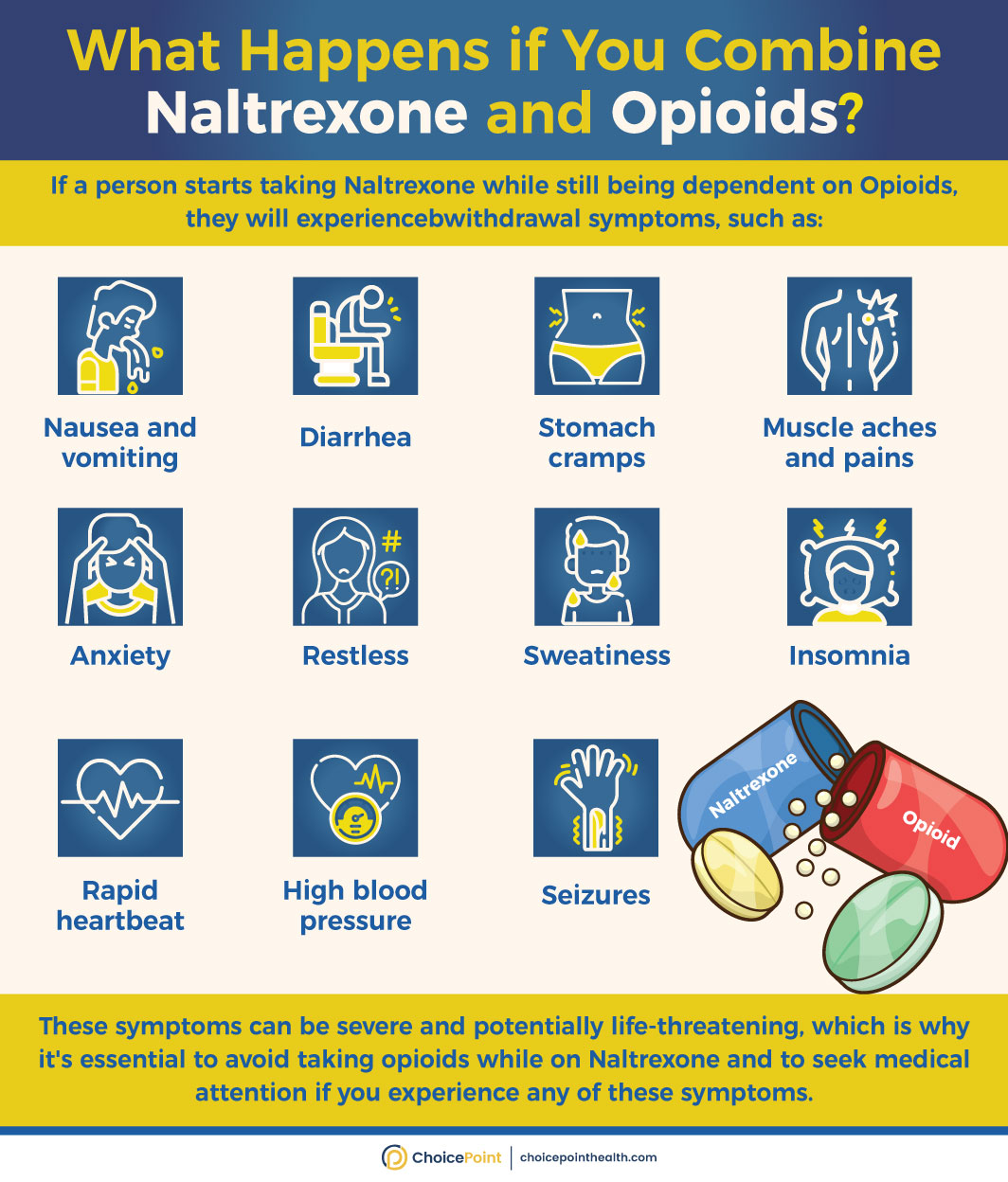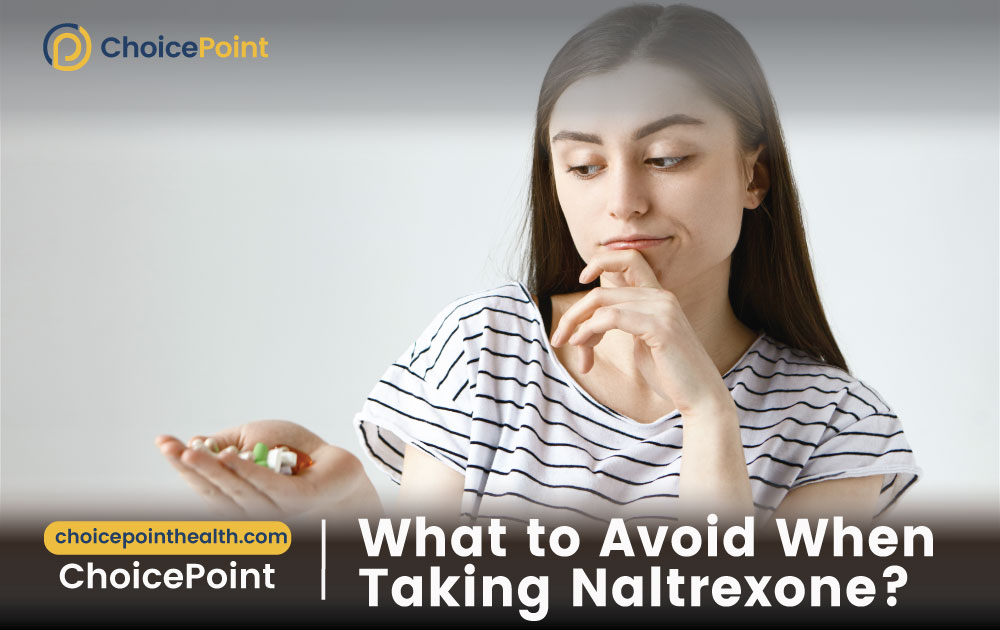Naltrexone can be a helpful MAT tool in your journey toward recovery, but it’s important to use it as prescribed to avoid any unwanted side effects. Knowing what to avoid while taking naltrexone ensures its efficacy and safety. In this article, we’ll look at what to avoid when taking Naltrexone so that you can make the most out of your treatment.
Table of Contents
What is Naltrexone, and How Does Naltrexone Work?
Naltrexone is a medication that falls under the opiate antagonist category. It works by blocking the effects of opioids in the brain, such as pain relief, feelings of well-being, and reducing the urge to use them. It’s typically part of a comprehensive treatment plan for individuals who have struggled with opiate addiction. This plan may include various measures such as:
- therapy
- lifestyle changes
- monitoring to help prevent relapse
Understanding Low-Dose Naltrexone (LDN) and Its Usage
Let’s discuss what is low dose Naltrexone is and what low dose Naltrexone used for. Low-dose naltrexone (LDN) is used off-label to treat a variety of conditions, including:
- autoimmune disorders
- chronic pain
- certain types of cancer
Unlike the higher doses of naltrexone, Low-Dose Naltrexone(LDN) is typically prescribed at 1-5 mg daily doses. The proper mechanism of Low-Dose Naltrexone(LDN) works by modulating the immune system and reducing inflammation.
At ChoicePoint, you can access the MAT program from the comfort of your home via virtual services. Our DEA-certified doctors will guide you on when to take Naltrexone. To schedule an appointment with our trusted doctors, call us at 844.445.2563.
Point to Ponder: When to Take Naltrexone?
You are probably wondering when to take Naltrexone. Well, Naltrexone administration is critical, as it must be taken after the individual has abstained from alcohol or opioids for at least 7 to 10 days. This waiting period allows the body to metabolize the substance fully and ensures that naltrexone doesn’t precipitate sudden withdrawal symptoms. After this waiting period, naltrexone can be taken one dose daily; otherwise, as a health professional proposes.
How Long Does Naltrexone Last?
The duration of action of Naltrexone depends on the formulation of the medication:
- The oral form of Naltrexone is typically taken once a day and has a half-life of about 4 hours. This means that the medication leaves the body relatively fast.
- In contrast, the extended-release injectable form of Naltrexone (Vivitrol) is administered once a month and has a longer duration of action, with a half-life of about 5-10 days.
It’s important to note that even though the medication is eliminated from the body relatively quickly, its effects on blocking opioid receptors can last for several days. As with any medication, it’s important to follow the dosing instructions provided by a healthcare provider and not to stop taking Naltrexone suddenly without consulting with a healthcare provider.

How Does Naltrexone Interact With Opioids?
Question of The Hour- What To Avoid When Taking Naltrexone
After discussing when to take Naltrexone, let’s talk about our main question: What to avoid when taking Naltrexone? Certain substances should be avoided to ensure the medication works properly and avoid negative health consequences. Here is a list of things to avoid when taking Naltrexone:
a. Opiates And Opiate-Containing Medications
Naltrexone works as an opiate antagonist, meaning it blocks the effects of opiates in the brain. Taking opiates while on Naltrexone can reduce the medication’s effectiveness and can even result in sudden withdrawal symptoms. The following Opiates should be avoided at all costs when taking Naltrexone:
- Heroin
- Morphine
- Codeine
- Oxycodone
- Tramadol
- Hydrocodone
b. Methadone
Methadone is an opioid medication used to treat pain and addiction. Taking Naltrexone while on methadone can cause sudden withdrawal symptoms.
c. Alcohol
Naltrexone can help people reduce their alcohol intake but avoid drinking while taking the medication. Drinking while on Naltrexone can lead to adverse reactions such as nausea, headache, and dizziness.
d. Certain Medications
Naltrexone interacts negatively with certain medications, including:
- Dextromethorphan- is used to treat colds, coughs, and flu
- Diphenoxylate- used to treat diarrhea
- Disulfiram- used to treat alcohol use disorder
- Thioridazine- used to treat schizophrenia
Did you know Naltrexone may interfere with a drug test and cause a false result? Therefore, it is better to trust a DEA-certified addiction specialist for conducting drug tests, either virtual or in person. ChoicePoint offers at-home drug tests that DEA-certified addiction specialists strictly supervise.
Naltrexone as a Form of Addiction Treatment at ChoicePoint
Naltrexone is an FDA-approved medication used in Medication-assisted treatment programs. It assists in treating Opioid use disorder and alcohol use disorder. Naltrexone is highly effective in decreasing the cravings for illicit substances. Moreover, it promotes a healthier lifestyle when combined with behavioral therapies like CBT and DBT.
If you or a loved one is struggling with substance abuse and needs to start a recovery journey, contact our highly qualified and DEA-certified addiction specialists today. You may start virtual or in-person addiction treatment plans at ChoicePoint by calling us at 844.445.2563.
What To Avoid When Taking Naltrexone – In Essence
Naltrexone can be an effective tool in treating opioid addiction and alcohol use disorder. However, it’s essential to know what to avoid when taking Naltrexone. Make sure to avoid taking alcohol, anti-depressants, and opiates like heroin.
Query Corner for What to avoid when taking Naltrexone
Find out all the answers to commonly asked questions about What to avoid when taking Naltrexone.
Can I Drink Alcohol While Taking Naltrexone, and Should I Avoid Certain Medications While Taking Naltrexone?
It is generally recommended that individuals avoid alcohol while taking Naltrexone because it reduces its effectiveness and increases the risk of side effects. Some medications may interact with Naltrexone, so check with your doctor before starting any new medications.
Can I Eat Grapefruit or Drink Grapefruit Juice While Taking Naltrexone?
Grapefruit and grapefruit juice may interact with Naltrexone, increasing the risk of side effects, so they should be avoided while taking this medication.
Should I Avoid Certain OTC Medications While Taking Naltrexone?
Some over-the-counter medications may interact with Naltrexone, so read labels carefully and talk to your doctor before starting any new medications.
Can I Drink Alcohol-Based Cough Syrups While on Naltrexone?
To avoid interactions and maintain the medication’s efficacy, avoid alcohol-containing cough syrups while taking Naltrexone.
Can I Use Naltrexone If I Have Liver Issues?
People with liver problems should use Naltrexone with caution and under the supervision of a doctor, as it may impair liver function.
Can I Use Naltrexone If I Have a History of Seizures?
Naltrexone may lower the seizure threshold in some people, so exercise caution and discuss any history of seizures with your doctor before beginning treatment.
Medical Disclaimer:
ChoicePoint aims to improve the quality of life for people struggling with substance use disorder and mental health issues. Our team of licensed medical professionals research, edit and review the content before publishing. However, this information is not intended to be a substitute for professional medical advice, diagnosis, or treatment. For medical advice please consult your physicians or ChoicePoint's qualified staff.










Review What to Avoid When Taking Naltrexone.